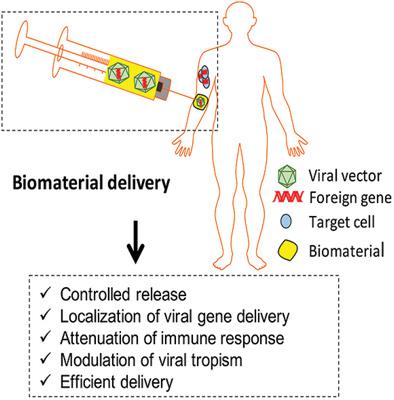当前位置:
X-MOL 学术
›
Adv. Healthcare Mater.
›
论文详情
Our official English website, www.x-mol.net, welcomes your
feedback! (Note: you will need to create a separate account there.)
Is Viral Vector Gene Delivery More Effective Using Biomaterials?
Advanced Healthcare Materials ( IF 10.0 ) Pub Date : 2020-11-16 , DOI: 10.1002/adhm.202001238 Yi Wang 1 , Kiara F. Bruggeman 1 , Stephanie Franks 1 , Vini Gautam 2 , Stuart I. Hodgetts 3, 4 , Alan R. Harvey 3, 4 , Richard J. Williams 5, 6 , David R. Nisbet 1, 6
Advanced Healthcare Materials ( IF 10.0 ) Pub Date : 2020-11-16 , DOI: 10.1002/adhm.202001238 Yi Wang 1 , Kiara F. Bruggeman 1 , Stephanie Franks 1 , Vini Gautam 2 , Stuart I. Hodgetts 3, 4 , Alan R. Harvey 3, 4 , Richard J. Williams 5, 6 , David R. Nisbet 1, 6
Affiliation

|
Gene delivery has been extensively investigated for introducing foreign genetic material into cells to promote expression of therapeutic proteins or to silence relevant genes. This approach can regulate genetic or epigenetic disorders, offering an attractive alternative to pharmacological therapy or invasive protein delivery options. However, the exciting potential of viral gene therapy has yet to be fully realized, with a number of clinical trials failing to deliver optimal therapeutic outcomes. Reasons for this include difficulty in achieving localized delivery, and subsequently lower efficacy at the target site, as well as poor or inconsistent transduction efficiency. Thus, ongoing efforts are focused on improving local viral delivery and enhancing its efficiency. Recently, biomaterials have been exploited as an option for more controlled, targeted and programmable gene delivery. There is a growing body of literature demonstrating the efficacy of biomaterials and their potential advantages over other delivery strategies. This review explores current limitations of gene delivery and the progress of biomaterial‐mediated gene delivery. The combination of biomaterials and gene vectors holds the potential to surmount major challenges, including the uncontrolled release of viral vectors with random delivery duration, poorly localized viral delivery with associated off‐target effects, limited viral tropism, and immune safety concerns.
中文翻译:

使用生物材料是否能更有效地传递病毒载体基因?
为了将外源遗传物质引入细胞中以促进治疗性蛋白的表达或使相关基因沉默,已经广泛研究了基因传递。这种方法可以调节遗传性或后生性疾病,为药物治疗或侵入性蛋白质递送选择提供有吸引力的替代方法。但是,病毒基因治疗的令人兴奋的潜力尚未完全实现,许多临床试验未能提供最佳的治疗效果。造成这种情况的原因包括难以实现局部递送,随后在靶位点的药效降低以及转导效率差或不一致。因此,正在进行的努力集中在改善局部病毒递送和提高其效率上。最近,生物材料已被用作控制更多,靶向和可编程的基因传递。越来越多的文献证明了生物材料的功效及其相对于其他递送策略的潜在优势。这篇综述探讨了基因传递的当前局限性以及生物材料介导的基因传递的进展。生物材料和基因载体的结合具有克服重大挑战的潜力,包括不受控制地释放病毒载体,随机传递持续时间,局部病毒传递较弱,相关脱靶效应,有限的病毒嗜性和免疫安全性。这篇综述探讨了基因传递的当前局限性以及生物材料介导的基因传递的进展。生物材料和基因载体的结合具有克服重大挑战的潜力,包括不受控制地释放病毒载体,随机传递持续时间,局部病毒传递较弱,相关脱靶效应,有限的病毒嗜性和免疫安全性。这篇综述探讨了基因传递的当前局限性以及生物材料介导的基因传递的进展。生物材料和基因载体的结合具有克服重大挑战的潜力,包括不受控制地释放病毒载体,随机传递持续时间,局部病毒传递较弱,相关脱靶效应,有限的病毒嗜性和免疫安全性。
更新日期:2021-01-06
中文翻译:

使用生物材料是否能更有效地传递病毒载体基因?
为了将外源遗传物质引入细胞中以促进治疗性蛋白的表达或使相关基因沉默,已经广泛研究了基因传递。这种方法可以调节遗传性或后生性疾病,为药物治疗或侵入性蛋白质递送选择提供有吸引力的替代方法。但是,病毒基因治疗的令人兴奋的潜力尚未完全实现,许多临床试验未能提供最佳的治疗效果。造成这种情况的原因包括难以实现局部递送,随后在靶位点的药效降低以及转导效率差或不一致。因此,正在进行的努力集中在改善局部病毒递送和提高其效率上。最近,生物材料已被用作控制更多,靶向和可编程的基因传递。越来越多的文献证明了生物材料的功效及其相对于其他递送策略的潜在优势。这篇综述探讨了基因传递的当前局限性以及生物材料介导的基因传递的进展。生物材料和基因载体的结合具有克服重大挑战的潜力,包括不受控制地释放病毒载体,随机传递持续时间,局部病毒传递较弱,相关脱靶效应,有限的病毒嗜性和免疫安全性。这篇综述探讨了基因传递的当前局限性以及生物材料介导的基因传递的进展。生物材料和基因载体的结合具有克服重大挑战的潜力,包括不受控制地释放病毒载体,随机传递持续时间,局部病毒传递较弱,相关脱靶效应,有限的病毒嗜性和免疫安全性。这篇综述探讨了基因传递的当前局限性以及生物材料介导的基因传递的进展。生物材料和基因载体的结合具有克服重大挑战的潜力,包括不受控制地释放病毒载体,随机传递持续时间,局部病毒传递较弱,相关脱靶效应,有限的病毒嗜性和免疫安全性。









































 京公网安备 11010802027423号
京公网安备 11010802027423号